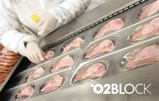Spain's NanoBioMatters Develops New Series Of Oxygen Scavengers For Plastics Packaging

NanoBioMatters, Valencia, Spain, a leading supplier of advanced organoclay additives, has announced the development of a new series of oxygen scavenging additives which can be dispersed directly into packaging materials, offering a simpler, less costly, and more convenient alternative to conventional scavenging techniques such as UV-activated systems and oxygen scavenger packets. O2 Block additive is primarily designed to maximize shelf life for diverse packaging made of materials such as LDPE, HDPE, PP, PET, and PLA for the food and pharmaceutical industries. NanoBioMatters made the announcement during K 2010 (Hall 8A Booth E12-10), the 18th International Trade Fair Plastics + Rubber, Oct. 27-Nov. 3, here in Dusseldorf, Germany.
The new proprietary and patent-pending O2 Block technology is based on surface-modified phyllosilicate clay that is functionalized with active iron to create a naturally sourced and highly efficient oxygen scavenging product. The technology's most innovative feature is the use of purified and modified layered clay as a performance-enhancing carrier of the oxygen-scavenging iron. Also unique is the ability for the active iron to be dispersed directly in the polymer during the production process. The technology is based on NanoBioMatters' proprietary and extensive know-how in surface modification and dispersion.
During the proprietary production process, active iron is linked to the clay surface and a uniform dispersion is achieved. In addition, the iron deposited on the clay prevents platelet agglomeration which combined with unique surface modification ensures total additive dispersion.
"Our novel technology provides greater versatility and efficiency than competitive oxygen scavenging systems," said Ole Faarbaek, vice president of NanoBioMatters North America. "The effective dispersion maximizes the access to the active iron which ensures minimum reaction time and a very uniform protection of the packaged goods."
Oxygen is depleted from the package by migrating through the packaging material and reacting with the dispersed active iron from the O2 Block additive. The reaction is swift and produces iron oxide which is linked inside the packaging.
All the ingredients in the O2 Block formulation are generally recognized as safe by the European Union and the U.S. Food and Drug Administration (FDA). Food-contact approval is expected early next year. The oxygen scavenger is supplied as a micronized powder or a masterbatch. Scavenging capacity is directly linked to the amount of active iron. Therefore, dosing is tailored to the individual application by adjusting the masterbatch loading and/or active clay content to meet the required scavenging performance. The oxygen scavenger can be used in loadings of 1% to 10% in HDPE, LDPE, PET, and PLA.
The O2 Block oxygen scavenger can also be used in combination with the company's unique O2 Block solution for EVOH multilayer barrier films, providing up to 50% reduction in oxygen transmission rate (OTR).
The developmental grades are being tested and evaluated by several leading food companies and commercialization is expected in early 2011. NanoBioMatters is also exploring development of other new antioxidants including the O2Block RS-R series, a line of radical scavengers that use a sustainable plant extract as the active ingredient.
SOURCE: NanoBioMatters
